

HUMAN RESOURCES INITIATIVES, POLICIES, AND MANAGEMENT SKILLS DEVELOPMENT. Prior to introducing process streamlining tools or pursuing specific process improvement projects, key Human Resources foundation tools were needed.
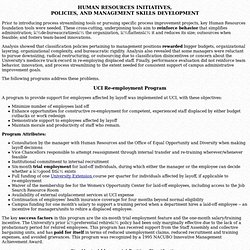
These cross-cutting, underpinning tools aim to reinforce behavior that simplifies administration; �de-bureaucratizes� the organization, �flattens� it and reduces its size; outsources when feasible; and fosters team-based innovations. Analysis showed that classification policies pertaining to management positions rewarded bigger budgets, organizational layering, organizational complexity, and bureaucratic rigidity.
Analysis also revealed that some managers were reluctant to pursue downsizing, radical restructuring, or outsourcing due to classification disincentives or concern about the University's mediocre track-record in re-employing displaced staff. The following programs address these problems. A program to provide support for employees affected by layoff was implemented at UCI, with these objectives: Program Attributes: 1. Past Issues. Library Management and Its Impact on Dysfunctional Staff. This article is from the October 2010 issue.

By Cherry-Ann Smart, APS, BA, MLS Evil reigns when good men fail to act. . – Edmund Burke Library literature abounds with advice on handling the difficult library patron (Willis, 1999; Sarkodie-Mensah, 2002; Schott, 2009). Yet information on handling the difficult library employee is harder to find. Could the shortcoming in the literature be attributed to the fact that MLS staff research only the areas in the profession perceived to be focal, optimistic or fixable? During the recession, my institution – amazingly – expanded its hours of operation.
How, then, to prevent dysfunction from choking a library’s mission and draining the energy of its middle managers? Establish Policy One of the least attractive tendencies I have observed among librarians is an intolerance for conflict. Policies should clearly indicate the steps to take when an employee deviates from stated guidelines.
Dysfunctional behavior does not happen overnight. References: The For-Profit Library? What Libraries and Learning Resource Centers Bring to the For-Profit College. This article is from the March 2011 issue.

By Jennifer Meyer, MLS I have worked in a for-profit college library for nearly four years. Taking the job was nerve racking for me originally. Guidelines for University Library Services to Undergraduate Students. Approved at ALA Annual Conference, June 2005 Introduction These guidelines are intended to apply to library services to undergraduate students at university libraries and to be used in conjunction with the ACRL Standards for Libraries in Higher Education [2004, ].

At some institutions a separate undergraduate library may exist; at others staff and programs devoted to undergraduates may be present in the context of the general library. References to undergraduate library services in these guidelines apply to both of these contexts. The guidelines are designed as a tool to help those providing services to undergraduate students in a large university setting establish individual goals for developing, maintaining and expanding those services within the context of their library’s and university’s goals.
Information seeking habits. E-JASL. Information Literacy -professional resources. University of King's College. General The University of King's College Library contains over 80,000 volumes.
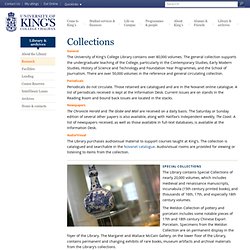
The general collection supports the undergraduate teaching of the College, particularly in the Contemporary Studies, Early Modern Studies, History of Science and Technology and Foundation Year Programmes, and the School of Journalism. Statistics. Statistics based on well designed research in many fields provide insights for further research and decision-making by leaders in both academic and ecclesial communities.
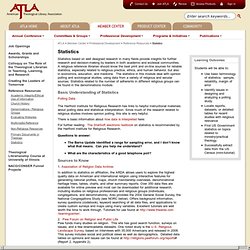
A religious reference librarian should know the best print and on-line sources for reliable statistics, especially related to religious practice, ethics, and human behavior, but also in economics, education, and medicine. The statistics in this module deal with opinion polling and sociological studies, using data from a variety of religious and secular sources. Trends in Librarianship as a Career. Return to ACRL Recruitment and Retention Wiki Homepage Overview DRAFT: This section is devoted to identifying trends in the recruitment and retention of academic librarians.
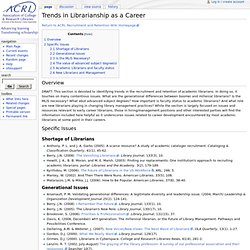
In doing so, it touches on many contentious issues. What are the generational differences between boomer and millenial librarians? Is the MLIS necessary? Two Current Initiatives in Continuing Education. Submitted by Richard Ellis I. The Federal Survey On November 25, 2009 I represented the Newfoundland and Labrador Library Association at a consultation session arranged by the Conference Board of Canada at the Masonic Temple in St. John’s, NFLD.
Rare books. Computer training. Clearance Center. Sense-Making Studies. Cardillo (1999): Sense-Making as Theory and Method. Electronic Journal of Communication. Issues 2, 3, 4 (Volume 9) of the Electronic Journal of Communication contain articles which exemplify the uses of the Sense-Making Methodology which has been under development by Brenda Dervin and colleagues for the past 27 years.
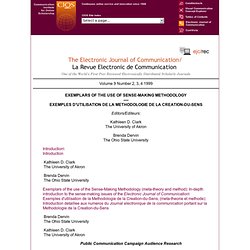
In contrast to most uses of the term methodology which either use the term synonymously with method or elide it into meta-theory, Sense-Making has been developed as an explicit attempt to be methodological -- i.e. to provide philosophically driven guidance for a coherent set of guiding methods for theorizing, observing, listening, analyzing, and concluding relevant to any communication practice, including research practice. Sense-Making incorporates an elaborate set of meta-theoretic assumptions, methodological premises, and specific tools including a variety of interviewing and coding approaches and a communication-as-procedure perspective which can potentially guide all research phases.
Kathleen D. Brenda Dervin The Ohio State University Kathleen D. Jayme E. Article from ejc/rec. Volume 9 Numbers 2, 3, 4 1999 Brenda Dervin The Ohio State University Columbus, Ohio USA dervin.1@osu.edu Kathleen D.

Clark The University of Akron Akron, Ohio USA kclark@uakron.edu Abstract.The purpose of this introductory essay to these three issues of the Electronic Journal of Communication focusing on the Sense-Making Methodology is to provide: (a) an overview of the 18 exemplar studies which constitute these issues; (b) a brief introduction to the Sense-Making Methodology; and (c) a beginning explanation of why authors writing from such diverse discourse communities with such diverse implementations share a common interest in and use of Sense-Making. The substantive foci represented by the exemplars include: public communication campaign and audience research; practitioner encoding; audience decoding; information seeking in context; health communication; and religious communication. Introduction A Brief Introduction to the Sense-Making Methodology Micheline Frenette. Robert Huesca.